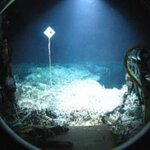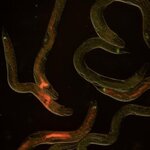Microbiology

Every few years, San Diego State researchers and Clorox get together and produce a study showing that the 'five second rule' - how long food can be on the floor and still be safe to eat - is not really true. Instead, germ transmission, like electricity, happens really fast. Researchers told us this in 2010, last year and they told us again today and various other times going back to 2003, when I stopped looking. It's almost like McClatchy/Tribune News is on a contract to give this stuff coverage but they aren't the only ones. It usually happens when it's a slow week for…

Unless you are a microbiologist, you probably don't want to think about all of the things that are happening in your mouth right now.
One thing you share with microbiologists is incomplete knowledge regarding what determines the specific types of microorganisms that live there. Is it genes that decide who lives in your microbial village, or your environment? In a new paper, researchers contend that environment plays a much larger role in determining oral microbiota than biology, a finding that sheds new light on a major factor in oral health.
Our oral microbiome begins to take shape as…
Are you a probiotic manufacturer who has become annoyed you are not allowed to market microbes that can help cultivate “intestinal flora” for consumers? Did the European Food Safety Authority tell you to stop claiming your magic potion reduces the chances of people developing diarrhea or respiratory tract infections? Did the U.S.A. force you to stop advertising that Activia yogurt and DanActive dairywhatever helps avoid colds or flu and force you to pay $21 million as part of a class-action settlement with the Federal Trade Commission and 39 states?
Do you wish you could go back to those…

Gold has reached an all-time high and researchers have discovered a bacterium's ability to withstand incredible amounts of toxicity is key to creating 24-karat gold.
Alchemy was once a pipe dream of ancient chemistry but now it is entirely possible, if you have enough energy. In the metal-tolerant bacteria Cupriavidus metallidurans it instead takes massive amounts of toxicity; the bacterium can grow on gold chloride, liquid gold, a toxic chemical compound found in nature.
The bacteria are also at least 25 times stronger than previously reported, the researchers determined in…

Soil bacteria and bacteria that cause human diseases have recently swapped at least seven antibiotic-resistance genes, according to researchers at Washington University School of Medicine in St. Louis.
Most of the antibiotics used to fight illness today originated from the soil. Bacteria use the antibiotics, in part, as weapons to compete with each other for resources and survival. Scientists have long acknowledged that gives environmental bacteria an evolutionary incentive to find ways to beat antibiotics.To what extent does that make disease-causing pathogens harder to control? It's unclear…

Helpful bacteria that processors add to acidify the sausage and make it safe for consumption are weakened by antibiotic residues in uncured pepperoni or salami meat, according to a new small-scale lab study in mBio. Researchers studying the effects antibiotic residues in fermented sausages found that antibiotic concentrations within limits set by US and European Union (EU) regulators are high enough to slow fermentation, a process that acidifies the sausages and should destroy foodborne pathogens like Salmonella or E. coli.
Antibiotics used as growth promoters or to treat disease in…

A little nuclear robot on Mars is getting all of the attention this week but Earth has plenty of undiscovered life - a third of Earth's organisms live in our planet's rocks and sediments and they are almost a complete mystery.
Science mysteries are meant to be solved and so researchers have reported the first detailed data on methane-exhaling microbes that live deep in the hydrothermal vents of hot undersea volcanoes. Just as biologists studied the habitats and life requirements of giraffes and penguins when they were new to science, says microbiologist James Holden of the University of…

Scientists have combined the power of two kinds of microscope to produce a 3-dimensional movie of how cells ‘swallow’ nutrients and other molecules by engulfing them - the first to follow changes in the shape of the cell’s membrane and track proteins thought to influence those changes.
This ‘swallowing’, called endocytosis, is involved in a variety of crucial tasks. It is used by brain cells relaying information to each other and is also hijacked by many viruses, which use it to invade their host’s cells. When a cell is about to swallow some molecules, a dent appears in the cell’s membrane,…

Living in the guts of worms are seemingly innocuous Photorhabdus luminescens bacteria that contribute to the worms' survival. Yet with a flip of a genetic switch, those same bacteria transform from harmless microbes into deadly insecticides.How the photorhabdus bacteria and a single promoter inversion switches it from an upstanding community member in the gut microbiome to deadly killer in insect blood is the subject of a new study. The bacteria in question are bioluminescent insect pathogens. In their mutualistic state, they reside in the intestines of worms, growing slowly…

More than 600 million people could be fed each year by halting the spread of fungal diseases in the world's five most important crops - rice, wheat, maize, potatoes and soybeans
Recent data further suggests that in 70% of cases where infectious disease causes the extinction of a type of animal or plant, an emerging species of fungus is behind the problem.
Fungal infections presently destroy at least 125 million tons of rice, wheat, maize, potatoes and soybeans, crops which provide the majority of calories consumed by people. The damage caused by fungi to rice, wheat and maize…